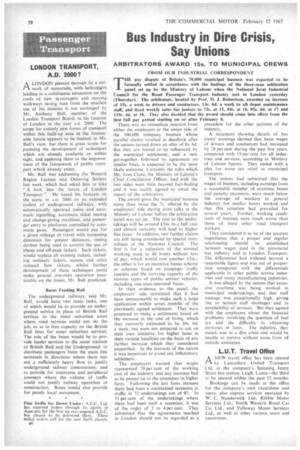LONDON TRANSPORT, A.D. 2000?
Page 40

If you've noticed an error in this article please click here to report it so we can fix it.
ALONDON pierced through by a netwc4k of monorails, with helicopl,ers landing in a continuous succession on the roofs of new skyscrapers and moving walkways saving man from the smallest use of his muscles is not envisaged by Mr. Anthony Bull, member of the London Transport Board, in his forecast of London in the year A.D. 2000. The scope for entirely new forms of transport within this built-up area in the foreseeable future appears to be limited, in Mr. Bull's view, but there is great scope for pursuing the development of techniques which are already available or within sight, and applying them to the improvement of the framework of public transport which already exists.
Mr. Bull was addressing the Western Region Lecture and Debating Society last week, which had asked him to take
A look into the future of London Transport ", He based his forecast on the scene in A.D. 2000 on an extended system of underground railways, with automatically operated trains and automatic signalling, automatic ticket issuing and change-giving machines, and passenger entry to platforms controlled by automatic gates. Passengers would pay for a given mileage of travel with increasing discounts for greater distances, timing devices being used to control the use of cheap and off-peak tickets. Such tickets, would replace all existing tickets, including ordinary tickets, season and other reduced fare tickets, whilst further development of these techniques could make general one-man operation practicable on the buses, Mr. Bull predicted.
Buses Feeding Rail The underground railways, said Mr. Bull, would have two main tasks, one of which would be to provide an underground service in place of British Rail services in the inner suburban areas where road services could not do the job, so as to free capacity on the British Rail lines for outer suburban services. The role of the buses would be to provide feeder services to the outer stations of British Rail and the Underground: to distribute passengers from the main line terminals in directions where there was not a sufficiently heavy flow to justify underground railway construction; and to provide for transverse and peripheral journeys where the volume of traffic could not justify railway operation or construction. Buses would also provide for purely local movement.
First Swifts for Down Under: A.E.C. Ltd. has received orders through its agents in Australia for the first six rear-engined A.E.C. bus chassis to be delivered there. These initial orders call for the new Swift chassis.
B6






























































































































